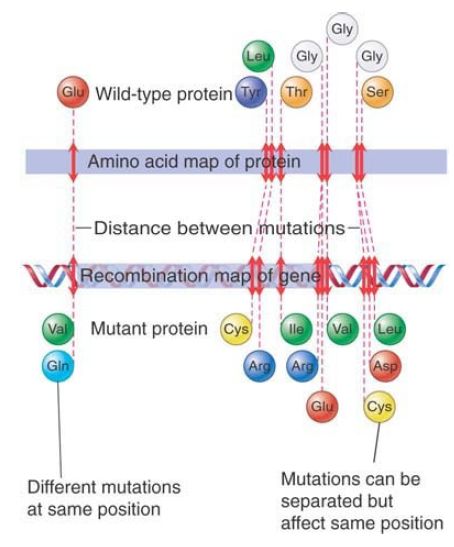
Bacterial Genes Are Colinear with Their Products
 المؤلف:
JOCELYN E. KREBS, ELLIOTT S. GOLDSTEIN and STEPHEN T. KILPATRICK
المؤلف:
JOCELYN E. KREBS, ELLIOTT S. GOLDSTEIN and STEPHEN T. KILPATRICK
 المصدر:
LEWIN’S GENES XII
المصدر:
LEWIN’S GENES XII
 الجزء والصفحة:
الجزء والصفحة:
 3-3-2021
3-3-2021
 2797
2797
Bacterial Genes Are Colinear with Their Products
KEY CONCEPTS
-A bacterial gene consists of a continuous length of 3N nucleotides that encodes N amino acids.
-The gene is colinear with both its mRNA and polypeptide products.
By comparing the nucleotide sequence of a gene with the amino acid sequence of its polypeptide product, we can determine whether the gene and the polypeptide are colinear—that is, whether the sequence of nucleotides in the gene exactly corresponds to the sequence of amino acids in the polypeptide. In bacteria and their viruses, genes and their products are colinear.
Each gene is a continuous stretch of DNA with a coding region that is three times the number of amino acids in the polypeptide that it encodes (due to the triplet nature of the genetic code). In other words, if a polypeptide contains N amino acids, the gene encoding that polypeptide contains 3N nucleotides.
The equivalence of the bacterial gene and its product means that a physical map of DNA will exactly match an amino acid map of the polypeptide. How well do these maps match the recombination map?
The colinearity of gene and polypeptide was originally investigated in the tryptophan synthetase gene of E. coli. Genetic distance was measured by the percentage of recombination between variable sites in the DNA; amino acid distance was measured as the number of amino acids separating sites of amino acid replacement.
FIGURE 1. compares the two maps; the wild-type protein sequence is illustrated on top, highlighting the seven amino acids that were replaced in the mutant protein (shown below). The order of seven variable sites is the same as the order of the corresponding sites of amino acid replacement, and the recombination distances are roughly similar to the actual distances in the protein. The recombination map expands the distances between some variable sites, but otherwise there is little distortion of the recombination map relative to the physical map.

FIGURE 1. The recombination map of the tryptophan synthetase gene corresponds with the amino acid sequence of the polypeptide.
The recombination map leads to two further general points about the organization of the gene. Different mutations can cause a wildtype amino acid to be replaced with different alternatives. If two such mutations cannot recombine, they must involve different point mutations at the same position in DNA. If the mutations can be separated on the genetic map but affect the same amino acid on the upper map (the connecting lines converge in the figure), they must involve point mutations at different positions in the same codon. This happens because the unit of genetic recombination (1 bp) is smaller than the unit encoding the amino acid (3 bp).
 الاكثر قراءة في مواضيع عامة في الاحياء الجزيئي
الاكثر قراءة في مواضيع عامة في الاحياء الجزيئي
 اخر الاخبار
اخر الاخبار
اخبار العتبة العباسية المقدسة


